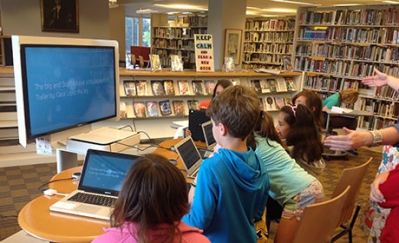Building the Learning Environment: Climate Conducive to Learning
Update December 2020:
This web page is a companion to the 2016 version of the School Library Program Rubric. NYSED released an updated School Library Program Rubric in December 2020.
Student Snapshot: Students seek opportunities to visit the library media center; library atmosphere invites all to explore, read and learn; provisions for diverse student needs are met.
The National School Climate Center (n.d.). defines school climate as “the quality and character of school life. School climate is based on patterns of students', parents' and school personnel's experience of school life and reflects norms, goals, values, interpersonal relationships, teaching and learning practices, and organizational structures.”
Source: National School Climate Center. “School Climate.” National School Climate. National School Climate, 5 February 2016.
Citation for Photo: Francis W. Parker School. 2015. 21st Century Libraries: The Learning Commons. Francis W. Parker School. Edutopia.
In Practice
6 Management Practices for Affecting Workplace Climate
Description: This resource provides an overview of what climate is, its relevancy to the workplace, and how it can be demonstrated.
Resource/Citation: Freifeld, Lorri. “6 Management Practices for Affecting Workplace Climate.” Training; the Source for Professional Development, 30 March 2012.
Can We Be Purveyors of Joy and Delight?
Description: Use a positive mind-set to attempt to combat stress in schools today. It is important that school librarians adopt this in their programs.
Citation: Bell, Mary Ann. “Can We Be Purveyors of Joy and Delight?”. Internet@Schools, An Educator's Guide to Technology and the Web, 1 September, 2015.
Climbing to Excellence; Defining Characteristics of Successful Learning Commons
Description: The resource title below includes articles on the concept of the “Learning Commons” and how it positively impacts school culture.
Resource/Citation: Loertscher, David V.; Koechlin, Carol "Climbing to Excellence: Defining Characteristics of Successful Learning Commons." Knowledge Quest, v42 n4 p14-15 Mar-Apr 2014.
Library to Learning Commons: A Recipe for Success
Description: Converting a school library to a learning commons, fosters collaboration, inquiry, and a new environment for learning.
Resource/Citation: Hayes, Terri. “Library to Learning Commons: A recipe for success.” Education Canada, vol. 56, no. 3, January, 2014.
The School Learning Commons Knowledge Building Center
Description: A companion website to the second edition of the book: The New Learning Commons Where Learners Win!, this website provides a myriad of resources relating to learning commons.
Resource/Citation: The School Learning Commons Knowledge Building Center.
School Libraries and Makerspaces: Can They Coexist?
Description: Makerspaces and school libraries support constructivist learning but they are not one and the same. This article discusses the importance of to finding a balance in a building and how these different initiatives can work together.
Resource/Citation: Weisgrau, Josh. “School Libraries and Makerspaces: Can They Coexist?” Edutopia, 25 Sept. 2015.
What’s in a Name: Reimagining the School Library Program
Description: This article discusses personalized learning, new types of spaces, technology, and making sure there is a central place for the library program in twenty-first century learning environments.
Resource/Citation: Easley, Michelle, and Marie Yelvington. “What’s in a Name? Reimagining the School Library Program.” Teacher Librarian, vol. 42, no. 5, 2015.
In Theory
The Empire State Information Fluency Continuum
Description: The ESIFC emphasizes the importance of inquiry in learning and establishes information fluency standards for grades K-12, which are aligned with Common Core Learning Standards. The fusion of the two sets of standards aims to create students who are capable of absorbing and applying appropriate information to any situation. The document identifies three information literacy standards which encourage students to be thinkers, explorers, and citizens and outlines the essential steps of inquiry: connect, wonder, investigate, construct, express, and reflect. The continuum also includes grade-specific benchmarks for information skill development and sample diagrams and worksheets which may be used to assess students’ progress. Finally, there is a helpful chart for administrators, teachers, and librarians that links progress along the fluency continuum with various Common Core Learning Standards in reading, writing, and speaking & listening. The continuum helps apply Common Core Learning Standards to real-world classroom teaching and is a great resource to use for grade-specific lesson planning.
Resource/Citation: New York City School Library System. “The Empire State Information Fluency Continuum.” Engage NY, 7 Nov. 2014.
The Relationship Between School Culture and the School Library Program: Four Case Studies
Description: This research describes the results of a cross-case analysis of four individual case studies at schools having nationally recognized school library programs. The focus of the study is on the culture of the school as an organization and its effect on establishing an effective school library program. The purpose of the study was to identify cultural themes at each school.
Resource/Citation: Howard, Jody K. “The Relationship Between School Culture and the School Library Program: Four Case Studies.” School Library Research, vol. 13, 2010.
Educational Administration: Theory, Research, and Practice
Description: One of the most widely read books in educational leadership, Educational Administration uses a systems perspective to synthesize the relevant theory and research on organizational behavior and focuses on understanding and applying theory to solve problems of practice.
*Resource/Citation: Hoy, Wayne K. & Miskel, Cecil G. Educational Administration: Theory, Research, and Practice, 9th edition. McGraw-Hill, 2013.
Lesbian, Gay, Bisexual, Transgender, and Questioning (LGBTQ)-Themed Literature for Teens: Are School Libraries Providing Adequate Collections?
Description: The purpose of this study was to determine if young adults have access through school libraries to LGBTQ-themed literature. The library collections in 125 high schools in one Southern U.S. state were examined for the inclusion of LGBTQ-themed fiction, nonfiction, and biographies, including a core collection of 21 recommended titles. Although LGBTQ teens are estimated to make up 5.9 percent of the students in American high schools, the average number of LGBTQ-themed titles held by these school libraries was 0.4 percent. Suggestions for further study are included.
Resource/Citation: Hughes-Hassell, Sandra, Elizabeth, Overberg, and Shannon Harris. “Lesbian, Gay, Bisexual, Transgender, and Questioning (LGBTQ)-Themed Literature for Teens: Are School Libraries Providing Adequate Collections?” School Library Research, vol. 16, 2013.
Inequalities in School Climate in California
Description: School climate, or the physical and social conditions of the learning environment, has implications for academic achievement. This paper aims to discuss this issue using a design/methodology approach. The authors examine how school climate varies by school-level characteristics in California using administrative data and the California School Climate Survey.
Resource/Citation: Jain, Sonia, Alison K. Cohen, Kevin Huang, Thomas L. Hanson, and Gregory Austin. "Inequalities In School Climate In California." Journal Of Educational Administration, 2015.
Stealing the Limelight? Examining the Relationship Between New Librarians and Their Supervisors
Description: This study was conducted in order to determine how supervisor support relates to a new librarian's job satisfaction and organizational commitment. Factors examined include whether librarians in positions of power are reluctant to foster growth in beginning librarians and, if so, whether this reluctance is due to feelings of insecurity or fear of being outshone. This paper also examines the effect a supervisor's reluctance to offer advice and mentoring on the psychological state of new librarians. Suggestions for future research are discussed.
*Resource/Citation: Mallon, Melissa N. "Stealing The Limelight? Examining The Relationship Between New Librarians And Their Supervisors." The Journal Of Academic Librarianship, vol. 40, 2014, pp. 597-603.
Stakeholders as Researchers: A Multiple Case Study of Using Cooperative Inquiry to Develop and Document the Formative Leadership Experiences of New School Library Professionals
Description: Cooperative inquiry, a form of qualitative research used in community building, has not often been applied in educational contexts. Through the lens of formative leadership theory, the researchers studied the abilities of three new school librarians trained in cooperative inquiry and leadership to engage in collaborative problem solving for technology-related school challenges.
Citation: Mardis, Marcia A., and Nancy Everhart. "Stakeholders as Researchers: A Multiple Case Study of Using Cooperative Inquiry to Develop and Document the Formative Leadership Experiences of New School Library Professionals." Library And Information Science Research, vol. 36, 2014, pp. 3-15.
Consultant
Name: Diana Wendell
Email: dwendell@moboces.org
Bio: Diana is School Library System Director at Orange-Ulster BOCES in Goshen, NY; previously SLS Director at Madison-Oneida BOCES, and before that a school library media specialist for six years. She holds a CAS in Educational Leadership from SUNY Cortland. Diana was President of the NYS Educational Media Technology Association for two terms and was Chair of the SLSA Online Resources Committee for five years.
*To access restricted database articles speak with your school librarian or public librarian.







